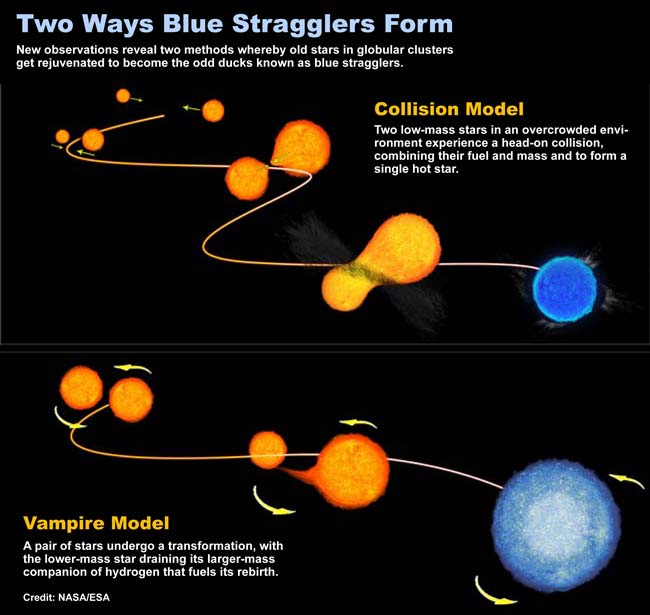Stars Find Fountain of Youth Via Vampirism and Collisions

Mysteriousold stars that look oddly young found the fountain of youth via two means, newresearch finds. Some rely on vampirism to suck the life out of a companionstar, while others are rejuvenated in cosmic collisions.
The strangestars exist among a tight group of stellar geezers in what's called a globularcluster. The whole setup called Messier 30 ?an ancient knot of stars sitting 28,000 light-years away and within our MilkyWay galaxy ? is thought to have hit the scene about 13 billion years ago, whenthe universe was an infant.
Most of thestars look their age, bloated redgiants that are about to call it quits. But a few, called blue stragglers,seem to have regained their youth. They look very much like hot young things.
"It'slike seeing a few kids in the group picture of a rest-home for retiredpeople," said Francesco Ferraro of the University of Bologna in Italy."It is natural to wonder why they are there."
Fornearly 50 years, astronomers have known of these blue stragglers. The leadingtheory to explain them is vampirism.
Itworks like this: Two stars orbit each other in a tight setup. The less massiveone siphons fresh hydrogen from its more massive companion star, just as avampire would suck blood from a lover. The new fuel causes the smaller star toheat up, growing bluer ? known signs of a stellar hottie.
However,when Ferraro and colleagues used the Hubble Space Telescope to study the bluestragglers, they found two distinct populations, suggesting an alternate pathto immortality.
Get the Space.com Newsletter
Breaking space news, the latest updates on rocket launches, skywatching events and more!
Inthe new scenario, two starscollide nearly head-on, mixing their nuclear fuel to restart the fires ofcosmic youth.
"Ourobservations demonstrate that blue stragglers formed by collisions haveslightly different properties from those formed by vampirism," said studyteam member Giacomo Beccari from the European Space Agency. "This providesa direct demonstration that the two formation scenarios are valid and that theyare both operating simultaneously in this cluster."
Theresults are detailed in the Dec. 24 issue of the journal Nature.
Theastronomers also found that blue stragglers are much more concentrated towardthe center of the cluster, compared with other stars that are spread throughoutthe cluster.
"Thisindicates that blue stragglers are more massive than the average star in thiscluster," Ferraro said. "More massive stars tend to sink deep intothe cluster the way a billiard ball would sink in a bucket of honey."
Infact the central area of the cluster is quite crowded, so star pairing andcollisions are to be expected. Also, more massive stars near the cluster'scenter are exactly what would be expected from both the vampire model (becauseit involves the heft of two stars) and from mergers resulting from collisions.
Here'swhat researchers figure happened:
About2 billion years ago, the core of Messier 30 collapsed, throwing stars towardthe center. More collisions occurred, generating more of the newfound type ofblue straggler. The same growing crowd perturbed the two-star setups, fuelingvampirism.
"Almost10 percent of galactic globular clusters have experienced core collapse, butthis is the first time that we see the effect of the core collapse imprinted ona stellar population," said team member Barbara Lanzoni of the Universityof Bologna.
- White Christmas: The Coldest Places in the SolarSystem
- The Wildest Weather in the Galaxy
- The Strangest Things in Space
Join our Space Forums to keep talking space on the latest missions, night sky and more! And if you have a news tip, correction or comment, let us know at: community@space.com.

Rob has been producing internet content since the mid-1990s. He was a writer, editor and Director of Site Operations at Space.com starting in 1999. He served as Managing Editor of LiveScience since its launch in 2004. He then oversaw news operations for the Space.com's then-parent company TechMediaNetwork's growing suite of technology, science and business news sites. Prior to joining the company, Rob was an editor at The Star-Ledger in New Jersey. He has a journalism degree from Humboldt State University in California, is an author and also writes for Medium.









